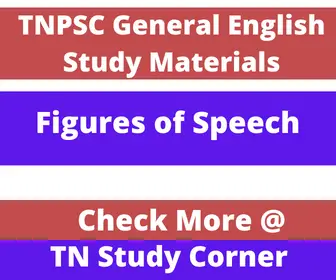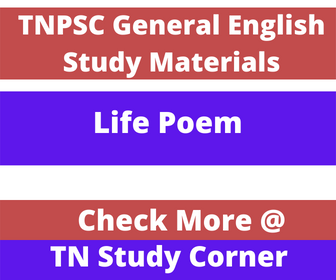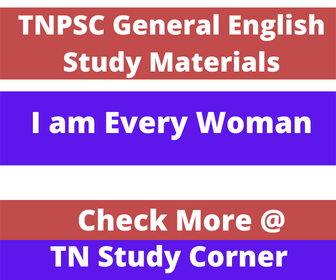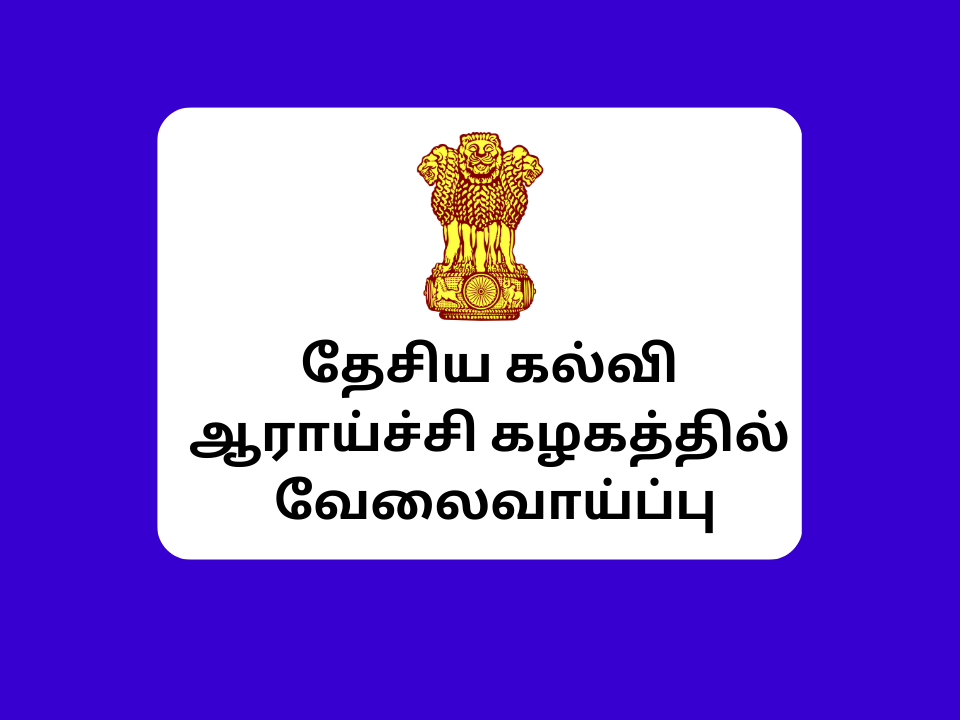TNPSC General English Study Materials Figures of Speech
Dear Friends,
We are adding TNPSC General English Study Materials Figures of Speech, TN Study Corner, a premium web portal for providing study materials and Job alerts, You can download TNPSC General English Study Materials Figures of Speech as pdf, check the download link for PDF
Note:
- These study material is prepared using newly updated books
- Join our WhatsApp Group . telegram channel for Daily TNPSC updates
|
Join Our Groups |
|
| TNPSC WhatsApp Group | Click here |
| Telegram Channel | Click here |
| Job alerts WhatsApp group | Click here |
| Job alerts Telegram group | Click here |
Figures of Speech
-
Alliteration
Alliteration is the reputation of the same consonant letters or similar sounds at the beginning words in a set or series of words.
For example: “For simple sheep; and such are daffodils.” In this line simple and sheep both the words start with same consonant.
wild, wind
curious, clock
splendid, scholar
memorable, moments
creepy, crawlies
-
Simile:
A ‘Simile’ is a figure of speech, in which two unlike things are compared, using the words, ‘like’ or ‘as’.
It is used to bring a dramatic effect in Prose.
Examples:
- as blind as a bat (means that someone is not willing to notice)
- like peas in a pod (means that two people are quite similar)
- as wise as an owl (refers to someone who is very smart/knowledgeable)
- quiet like a mouse (refers to someone who is silent / quiet)
- as brave as a lion (refers to someone who is too brave/courageous)
-
Metaphor:
A ‘Metaphor’ is quite similar to a ‘Simile’, as a ‘Metaphor’ also compares two unlike things. But a Metaphor has an implied or a hidden meaning between unrelated things.
Here, for a Metaphor we do not use words such as ‘like’ or ‘as’. Unlike Similes which compare two things
Metaphors directly state a comparison to things that are in no way similar.
Examples:
- My father was boiling mad (implies that he was too angry)
- She is the apple of my eye. (implies that she is too dear to me)
- Your brain is a computer. (implies that your brain is smart and quick)
- Her voice is music to his ears. (implies that her voice makes him feel happy)
- The given task was a breeze (implies that the task was not difficult)
-
Personification
Personification is a figure of speech in which a thing, an idea or an animal is given a human attribute.
Human qualities are given to non-human things or ideas, for a better understanding the writer’s message.
The use of personification also helps to show a character’s attitude towards inanimate objects.
Examples:
- The Sun smiled down upon them.
- Justice is blind.
- The wind howled in the night.
- The moon played hide and seek with the clouds.
- The city never sleeps at night.
- The boat danced in the puddle.
-
Onomatopoeia
A figure of speech wherein the word imitates the sound associated with the object it refers to
e.g. Pitter patter, pitter patter Raindrops on my pane

-
Consonance:
Repetition of similar consonant sounds in the neighbouring words.
(e.g.) T’is the prettiest little parlour that ever you did spy;
-
Assonance:
Repetition of similar vowel sounds in the neighbouring words
(e.g.) ‘T is the prettiest little parlour that ever you did spy;
-
Anaphora
is the repetition of a certain word or phrase at the beginning of successive lines of writing or speech.
(e.g.) Sea that line hath never sounded, Sea that sail hath never rounded
-
Rhyme scheme
Rhyme Scheme is a poet’s deliberate pattern of lines that rhyme with other lines in a poem or a stanza. The rhyme scheme, or pattern, can be identified by giving end words that rhyme.
But remember, please, the Law by which we live , ………… a
We are not built to comprehend a lie , ………… b
We can neither love nor pity nor forgive , ………… a
If you make a slip in handling us you die ! ………… b
Hence Rhyme Scheme is abab for the above poetic lines
It has a clear rhyming words with a,b,a,b so the rhyming scheme is a,b,a,b.
The rhyme is also clear with the same sound. E.g. pit-fit, ask-task, play-day
-
Repetition
Poets often repeat single words or phrases, lines, and sometimes, even whole stanzas at intervals to create a musical effect; to emphasize a point; to draw the readers’ attention or to lend unity to a piece
-
Epithet
is an adjective or phrase expressing a quality or attribute regarded as characteristic of the person or the thing mentioned.
(e.g.) Little river.
-
Imagery
is the name given to the elements in a poem that sparks the senses. It need not be only visual, it can relate any of the five senses (sight, hearing, touch, taste, smell)
(e.g.) yellow pebbles.
[su_button id=”download” url=”https://drive.google.com/file/d/18DAEJivVvDPTC4xhh2SM7cQGrZSnmeHS/view?usp=sharing” target=”blank” background=”#2d38ef” color=”#f1f1f0″ size=”6″ center=”yes” radius=”round”]Click here to Download [/su_button]





